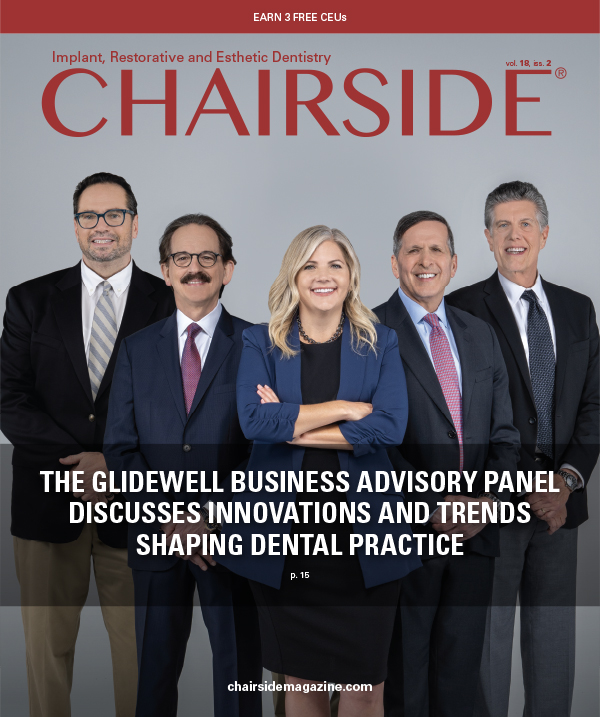The Finishing Touch: Neurotoxins in Esthetic Dentistry (1 CEU)

Beautiful teeth are like a work of art, and lips are the frame that highlight their beauty. When the lips lack balance, it affects the esthetic appeal of the overall smile — much like a crooked frame around a painting. When treating patients who want to improve their esthetics without further altering their teeth, neurotoxins can provide an affordable and convenient way to create picture-perfect smiles while boosting revenue for your practice.
HOW NEUROTOXINS WORK
While neurotoxin injections are more popularly known as a way to reduce wrinkles, they have proven to be an effective treatment option in esthetic dentistry. They disrupt the normal functioning of the nervous system by blocking the release of neurotransmitters at the synapse, which prevents nerve impulses from reaching the muscle fibers. Without these nerve impulses, the muscles remain in a relaxed state. Results can be detected within two weeks after the injection and last an average of 90 days.1
There are two facial muscles that have the greatest influence on the esthetic zone: the levator labii superioris alaeque nasi, and the orbicular oris. The levator labii superioris alaeque nasi is a strap muscle that elevates the upper lip and dilates the nostril. By applying neurotoxins to this region, the patient’s upper lip will relax into a lower position and cover more of the upper gingiva. The orbicular oris is a circumferential muscle involved in facial expression that can be injected to restore symmetry between the upper and lower lip. Procedures that affect the position of the upper lip are known as a lip drop, while procedures that adjust the balance of the lips are known as a lip flip.
LIP DROP PROCEDURES
When incorporating neurotoxins into your esthetic treatment planning, it’s important to identify which patients will benefit most from this procedure. The ideal candidate for a lip drop is happy with the shape, shade and orientation of their teeth, but they may feel self-conscious about their full genuine smile due to excessive gingival display.
This patient was satisfied with the esthetics of her dentition but sought treatment to address her disproportional show of maxillary gingival tissue. Together, we decided that she would benefit from neurotoxin injections to achieve her desired results. She had a wonderful outcome and is exceptionally happy with the results.
In this case, the patient did not want to close her diastema but did want to address her gummy smile. The results show a dramatic improvement in her esthetics, just 10 days after the application of neurotoxins. She was so pleased with her new look that she has repeated the procedure every few months.
LIP FLIP PROCEDURES
The ideal candidate for a lip flip procedure is unsatisfied with their lip volume and wants an affordable, natural-looking treatment. In my experience, these are patients who want results that are noticeable but not as dramatic as what can be achieved with lip fillers.
This case shows that you can accomplish a great esthetic outcome for your patient without committing to fillers. After the lip flip, her philtral columns appeared more defined, she had a more youthful appearance, and she was very happy with the results.
This patient was unsatisfied with her smile because her upper lip tucked and rolled in when she smiled, seemingly disappearing at the top of her teeth. After the lip flip procedure, her upper lip became more relaxed and displayed more natural esthetics with a greater volume of pink. She was hesitant about accepting treatment at first because she didn’t want her lips to look unnatural or inflated. After looking in the mirror, she was confident that she had made the right choice.
COMBINATION TREATMENTS
Some patients may benefit from a combination treatment of a lip drop and a lip flip. This patient had a fixed implant-retained hybrid denture placed several years prior to coming to my practice. The implant abutments were exposed and became unsightly due to her high smile line. Although not a definitive solution to her problem, I knew that her esthetics would benefit tremendously from neurotoxin treatment.
I presented her with a combination procedure that was readily accepted. It proved to be a great solution for her desire to temporarily cover this restorative deficiency until she could afford a permanent option. To ensure her ongoing dental health, I also referred her to a periodontist for maintenance of her implant prosthesis.
THE PROCEDURE
I recommend first marking the injection sites. Unlike dermal fillers, neurotoxins work on muscle tissue, and mapping the patient’s face ensures that each injection is as accurately placed as possible. Identifying the levator labii superioris alaeque nasi muscle attachment can be facilitated by asking the patient to smile.
To mark the injection sites on the orbicular oris, I asked the patient to return to a relaxed state since this superficial muscle is easy to locate. I then applied a topical disinfecting agent to the injection sites.
I used two units on each side of the nose to achieve a lip drop. To treat the patient with as little discomfort as possible, I used a Comfortox™ syringe (Comfortox; Cleveland, OH) because it has a very sharp needle. I used Jeuveau® botulinum injections (Evolus, Inc.; Newport Beach, Calif.) because I have observed that my patients tend to experience an earlier onset and longer duration compared to other available neurotoxins on the market.
To achieve a lip flip, I administer one injection per mark on the upper lip. This process does not require the use of anesthetic. While the injection sites are sensitive, most patients experience only slight discomfort during the procedure. To minimize any discomfort, I also massage the tissue while administering the injection.
The results confirmed that this patient was a great candidate for a combination treatment. The procedure reduced her gingival display and added volume by relaxing the upper orbicularis oris muscle. The unevenness of her gingival zenith between teeth #8 and #9 was concealed, and her upper lip volume matched that of her lower lip. This proved to be the ideal solution for someone who wanted conservative treatment.
PROFITABILITY
Dental implants, among the fastest growing procedures in dentistry, are projected to grow at a rate of 6.3% per year for the next five years.2 In contrast, botulinum toxins are expected to grow by 7.5% and facial injectables are predicted to grow by 9.6% over the same period.3,4 This prediction underscores the need for dental practices to consider expanding their service offerings beyond traditional dental procedures.
What was once performed only by plastic surgeons or dermatologists has now become a practical and affordable way to boost revenue for dental practices. Neurotoxins satisfy a growing demand among patients for nonsurgical esthetic treatments that enhance their appearance without requiring additional invasive procedures. In fact, most of my patients book injection appointments with me multiple times per year. Because it’s so affordable, they are willing to pay for their procedure immediately, out of pocket. This translates to a reliable, additional revenue stream for my practice. The requirement for dentists to offer this treatment is minimal and affordable, usually consisting of a two-day licensing and training course. Please note that regulations vary among states, and it is important to consult with your board of dentistry to determine their requirements for compliance.
CONCLUSION
Since I started offering neurotoxins in 2016, my practice has enjoyed a 2,000% increase in revenue from this procedure. I recommend that any doctor looking to expand their esthetic treatment options consider incorporating neurotoxins into their practice. Neurotoxins will only become more popular in the coming years, and it’s a great way to expand your services with an easy, affordable source of revenue.
All third-party trademarks are property of their respective owners.
Available CE Course
References
1. ^Satriyasa BK. Botulinum toxin (Botox) A for reducing the appearance of facial wrinkles: a literature review of clinical use and pharmacological aspect [Internet]. Clinical, cosmetic and investigational dermatology. New Zealand: U.S. National Library of Medicine; 2019 [cited 2023 Jul 19]. p. 223–228. Available from: https://www.ncbi.nlm.nih.gov/pmc/articles/PMC6489637/ PMCID: PMC6489637
2. ^Markets R and. Global Dental Implants Market 2020: Historic Analysis 2012-2019, COVID-19 Implications, Growth Deviations, Regional Insights and Forecasts to 2027 [Internet]. PR Newswire: press release distribution, targeting, monitoring and marketing. 2020 [cited 2023 Jul 19]. Available from: https://www.prnewswire.com/news-releases/global-dental-implants-market-2020-historic-analysis-2012-2019-covid-19-implications-growth-deviations-regional-insights-and-forecasts-to-2027-301066911.html
3. ^Fortune Business Insights. Global Botulinum Toxin Market Size 2021: To Hit USD 7.71 Billion at 7.5% CAGR by 2027; Increasing Awareness about the Therapeutic Benefits of Botox to Boost Market Prospects: Fortune Business Insights™ [Internet]. GlobeNewswire News Room. Fortune Business Insights; 2021 [cited 2023 Jul 19]. Available from: https://www.globenewswire.com/news-release/2021/04/12/2208237/0/en/Global-Botulinum-Toxin-Market-Size-2021-To-Hit-USD-7-71-Billion-at-7-5-CAGR-by-2027-Increasing-Awareness-about-the-Therapeutic-Benefits-of-Botox-to-Boost-Market-Prospects-Fortune-B.html
4. ^Facial Injectables Market Size, Share, Growth: Report [2028] [Internet]. Facial Injectables Market Size, Share, Growth | Report [2028]. [cited 2023 Jul 19]. Available from: https://www.fortunebusinessinsights.com/industry-reports/facial-injectables-market-100603














